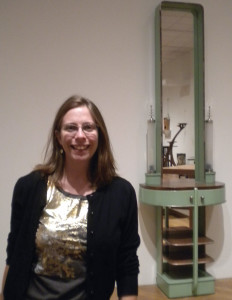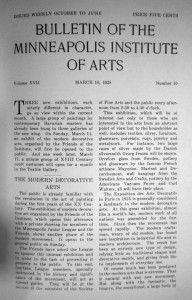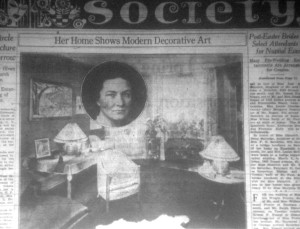Staging Modern Domesticity: Art and Constructed Interior Displays in America, 1925–1940
EMERGING SCHOLARS > SUMMER RESEARCH GRANTS
by Elizabeth McGoey, doctoral candidate at Indiana University in the Department of the History of Art
Elizabeth McGoey’s dissertation examines the interwar period when designers, critics, and the public frequently addressed the novelty and effectiveness of an allied approach to design harmonizing fine art and home furnishings. She focuses on the interrelationship of aesthetic objects in domestic environments staged for public audiences including world’s fair model homes; department store exhibitions; museum period rooms; and governmentally sponsored model interiors. Looking at these interiors as windows into the past, her study attempts to show how the intentional integration of aesthetic objects served to reify modernity for a mass audience.
Note: Thanks to the generosity of the Decorative Arts Trust, I was able to travel to Minneapolis to research an exhibition of modern decorative art held at the Minneapolis Institute of Fine Arts in 1928. While similar exhibits sponsored in New York City have received significant scholarly attention, little research addresses Midwestern sponsorship of modernist displays of domestic design. The research I conducted with support from the summer research grant greatly enriches my dissertation analyzing the interrelationship of fine arts, decorative arts, and furnishings presented to the public during the interwar period in the United States. I appreciate support from the Trust and welcome further discussion of my topic from members! I can be contacted at emcgoey@indiana.edu.
On March 10, 1928, the Minneapolis Institute of Arts opened an exhibition entitled “Modern Decorative Arts,” featuring decorative art objects giving “fresh life to implements of everyday use.” i Writing about the exhibition to one of the contributors, organizers described the plan to “bring together the best modern work with a view to acquainting our public with it, stimulating their interest and also sales wherever possible.” ii In a quest to capitalize on the cultural ascendancy of avant-garde aestheticism visible in Europe and particularly celebrated at the 1925 exposition in Paris, a number of American exhibitors like the Minneapolis Institute of Arts took their cues from, and adapted, the practice of exhibiting fully furnished mercantile and cultural displays. Heralded in their American nascence as novel examples of what modern domesticity should look like, staged domestic spaces attempted to inculcate a desire for the new and now amongst the viewing public. By integrating fine art, decorative art, and furnishings in the space, exhibitions were meant to entice viewers to visualize the lovely things in their own homes, thereby producing an effect making viewers yearn for a modern lifestyle.
With generous support from the Decorative Arts Trust, I set out to recover the details of this exhibition in Minnesota. In addition to scrutinizing curatorial records, internal administrative correspondence, and extant photographs of the show at the Minneapolis Institute of Arts, I also conducted research at the Minnesota History Center, mining newspapers for articles about the show as well as archival papers from the different businesses who participated in the exhibition. What emerged was an interesting narrative involving art institutions, businesses, community members, and evidence of widespread interest and enthusiasm for modernism in the Minneapolis community.
The show opened with great fanfare, as organizers from the Friends of the Minneapolis Institute of Art teamed with the Minneapolis Junior League to host a tea party opening the event, centering on a table set with silverware, textiles, plates and decorative objects by featured designers such as Swedish silversmith Geog Jensen. As a way to stimulate the connection between art and commerce and to generate greater publicity for the exhibition, organizers from Minneapolis Institute of Arts also worked with local department stores to highlight the accessibility of similar modern wares throughout the city. The president of the Friends of the Minneapolis Institute of Arts who headed up the show, Mrs. Sumner T. McKnight [pictured in clipping], appealed to W.H. Hayes of the Minneapolis Retailers Association for cooperation from association members by any means possible. Stores such as Dayton’s, Donaldson’s and Young-Quinlan obliged by launching ad campaigns visually influenced by avant-garde aesthetics [visible in the ad], and featured modern fashions and furnishings in window and store displays reflecting the modern spirit of Institute’s show. Many of the stores also loaned specific pieces to the museum for display including modernist pottery pieces, textiles, lamps, jewelry, and Lalique glass pieces. At the closing of the exhibition, the objects in the show were available for purchase with items such as an Orrefors glass bowl, Swedish-designed candlesticks, and modern jewelry noted as sold.iii
The opening tea party and the full run of the show attracted a large and enthusiastic audience. The exhibition space was said to be so crowded at times, it was difficult for viewers to inspect the objects on display. Likening the overflowing galleries in the Modern Decorative Arts show to the noteworthy masses that flooded similar exhibitions in New York City, the Museum Bulletin concluded modernism to be creating a real fervor, sweeping everything before it.iv This was echoed in newspaper reports of the show, with one critic claiming that any of the exhibited pieces could “be placed side by side with objects of good design of almost any period… there is nothing which could offend the most conservative eyes. And yet it is all new and different.”v
The Minneapolis Institute of Art’s intentional integration of aesthetic objects in an idealized physical space reified modernity for a mass audience. As a site of both taste education and promotion of a consumer ethos, exhibitions like this one shaped the American relationship between art and commerce that emerged during the interwar years—effectively conflating “the good life” with commercial goods while simultaneously setting the terms and definitions of modern domesticity for viewers.
Footnotes
“The Modern Decorative Arts,” Bulletin of the Minneapolis Institute of Arts 17, no. 10 (10 March 1928), 49.
Mrs. Sumner T. McKnight, letter to W.H. Hayes, 15 February 1928, Minneapolis Institute of Art Papers (Minneapolis, MN).
iii “Sales,” Bulletin of the Minneapolis Institute of Arts 17, no. 18 (21 April 1928), 49.
iv “Modern Art Again,” Bulletin of the Minneapolis Institute of Arts 17, no. 13 (31 March 1928), 62.
v Allen, Burt, “Modern Decorative Arts Exhibition to Open at the Institute of Arts Saturday,” The Minneapolis Tribune, March 4, 1928, Books and Art Section, 5.
SAVE THE DATE
- Special Symposium
“Classical Splendor”
The Philadelphia Museum of Art
November 4, 2016 - New York Antiques Weekend
January 20-21, 2017 - Spring Symposium
Savannah
April 21-24, 2017 - Spring Study Trip Abroad
Scotland
May 14-22, 2017 - Fall Symposium
Hartford & Western Connecticut
September 2017 - Fall Study Trip Abroad
Venice and the Veneto
October 9-16 and 22-29, 2017
by Elizabeth McGoey, doctoral candidate at Indiana University in the Department of the History of Art
Elizabeth McGoey’s dissertation examines the interwar period when designers, critics, and the public frequently addressed the novelty and effectiveness of an allied approach to design harmonizing fine art and home furnishings. She focuses on the interrelationship of aesthetic objects in domestic environments staged for public audiences including world’s fair model homes; department store exhibitions; museum period rooms; and governmentally sponsored model interiors. Looking at these interiors as windows into the past, her study attempts to show how the intentional integration of aesthetic objects served to reify modernity for a mass audience.
Note: Thanks to the generosity of the Decorative Arts Trust, I was able to travel to Minneapolis to research an exhibition of modern decorative art held at the Minneapolis Institute of Fine Arts in 1928. While similar exhibits sponsored in New York City have received significant scholarly attention, little research addresses Midwestern sponsorship of modernist displays of domestic design. The research I conducted with support from the summer research grant greatly enriches my dissertation analyzing the interrelationship of fine arts, decorative arts, and furnishings presented to the public during the interwar period in the United States. I appreciate support from the Trust and welcome further discussion of my topic from members! I can be contacted at emcgoey@indiana.edu.
On March 10, 1928, the Minneapolis Institute of Arts opened an exhibition entitled “Modern Decorative Arts,” featuring decorative art objects giving “fresh life to implements of everyday use.” i Writing about the exhibition to one of the contributors, organizers described the plan to “bring together the best modern work with a view to acquainting our public with it, stimulating their interest and also sales wherever possible.” ii In a quest to capitalize on the cultural ascendancy of avant-garde aestheticism visible in Europe and particularly celebrated at the 1925 exposition in Paris, a number of American exhibitors like the Minneapolis Institute of Arts took their cues from, and adapted, the practice of exhibiting fully furnished mercantile and cultural displays. Heralded in their American nascence as novel examples of what modern domesticity should look like, staged domestic spaces attempted to inculcate a desire for the new and now amongst the viewing public. By integrating fine art, decorative art, and furnishings in the space, exhibitions were meant to entice viewers to visualize the lovely things in their own homes, thereby producing an effect making viewers yearn for a modern lifestyle.
With generous support from the Decorative Arts Trust, I set out to recover the details of this exhibition in Minnesota. In addition to scrutinizing curatorial records, internal administrative correspondence, and extant photographs of the show at the Minneapolis Institute of Arts, I also conducted research at the Minnesota History Center, mining newspapers for articles about the show as well as archival papers from the different businesses who participated in the exhibition. What emerged was an interesting narrative involving art institutions, businesses, community members, and evidence of widespread interest and enthusiasm for modernism in the Minneapolis community.
The show opened with great fanfare, as organizers from the Friends of the Minneapolis Institute of Art teamed with the Minneapolis Junior League to host a tea party opening the event, centering on a table set with silverware, textiles, plates and decorative objects by featured designers such as Swedish silversmith Geog Jensen. As a way to stimulate the connection between art and commerce and to generate greater publicity for the exhibition, organizers from Minneapolis Institute of Arts also worked with local department stores to highlight the accessibility of similar modern wares throughout the city. The president of the Friends of the Minneapolis Institute of Arts who headed up the show, Mrs. Sumner T. McKnight [pictured in clipping], appealed to W.H. Hayes of the Minneapolis Retailers Association for cooperation from association members by any means possible. Stores such as Dayton’s, Donaldson’s and Young-Quinlan obliged by launching ad campaigns visually influenced by avant-garde aesthetics [visible in the ad], and featured modern fashions and furnishings in window and store displays reflecting the modern spirit of Institute’s show. Many of the stores also loaned specific pieces to the museum for display including modernist pottery pieces, textiles, lamps, jewelry, and Lalique glass pieces. At the closing of the exhibition, the objects in the show were available for purchase with items such as an Orrefors glass bowl, Swedish-designed candlesticks, and modern jewelry noted as sold.iii
The opening tea party and the full run of the show attracted a large and enthusiastic audience. The exhibition space was said to be so crowded at times, it was difficult for viewers to inspect the objects on display. Likening the overflowing galleries in the Modern Decorative Arts show to the noteworthy masses that flooded similar exhibitions in New York City, the Museum Bulletin concluded modernism to be creating a real fervor, sweeping everything before it.iv This was echoed in newspaper reports of the show, with one critic claiming that any of the exhibited pieces could “be placed side by side with objects of good design of almost any period… there is nothing which could offend the most conservative eyes. And yet it is all new and different.”v
The Minneapolis Institute of Art’s intentional integration of aesthetic objects in an idealized physical space reified modernity for a mass audience. As a site of both taste education and promotion of a consumer ethos, exhibitions like this one shaped the American relationship between art and commerce that emerged during the interwar years—effectively conflating “the good life” with commercial goods while simultaneously setting the terms and definitions of modern domesticity for viewers.
Footnotes
“The Modern Decorative Arts,” Bulletin of the Minneapolis Institute of Arts 17, no. 10 (10 March 1928), 49.
Mrs. Sumner T. McKnight, letter to W.H. Hayes, 15 February 1928, Minneapolis Institute of Art Papers (Minneapolis, MN).
iii “Sales,” Bulletin of the Minneapolis Institute of Arts 17, no. 18 (21 April 1928), 49.
iv “Modern Art Again,” Bulletin of the Minneapolis Institute of Arts 17, no. 13 (31 March 1928), 62.
v Allen, Burt, “Modern Decorative Arts Exhibition to Open at the Institute of Arts Saturday,” The Minneapolis Tribune, March 4, 1928, Books and Art Section, 5.




